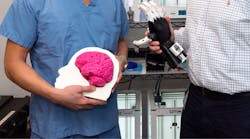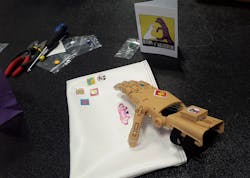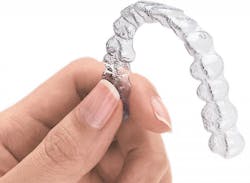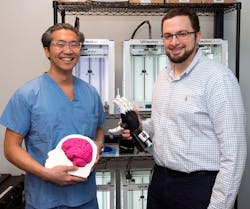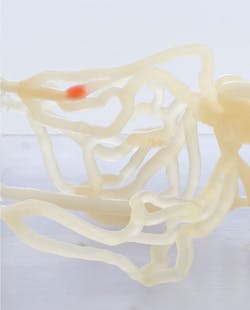“The Six Million Dollar Man” made Steve Austin a pop culture icon of the 1970s. The following decade marked the introduction of a technology that would lay the first layers for building bionic limbs, organs, hearing, and more. 3D printing has now advanced to the point where making replacements parts for humans is being seriously discussed. This technology isn’t currently giving anyone superhuman powers, but it might be able to extend the reach of doctors to help patients.
A new report from IDTechEx estimates the market for engineered living tissues is forecasted to reach $4.8 billion by the year 2028. The accompanying hype may have the public dreaming of printing hearts and lungs, but limitations of the technology will slow its introduction to the market, as will regulatory issues.
3D printing is already being used in some procedures, however. Both actual and potential medical uses for 3D printing can be organized by:
- The creation of customized prosthetics, implants, and anatomical models
- Tissue and organ fabrication
- Pharmaceutical research regarding drug dosage forms, delivery, and discovery
Available Today
Customized prosthetics. This is one of the most well-known ways in which 3D printing is improving life today. Custom prosthetics are expensive, and especially so in the case of children who are still growing. 3D printing is making a huge impact here.
Enable is just one organization that is lending a hand. It was started in 2013 as a simple Google+ group by Jon Shull, a professor at the Rochester Institute of Technology (RIT), and pairs makers with 3D printers with people in need of a low-cost hand prosthetic. There are companies that do more than hands, too—printing legs, feet, and various braces and splints for growing children.
One interesting thing about Enable is that it’s all open-source. A community of makers are designing and modifying these prosthetics online where anyone can alter designs, download, or print a prosthetic. Shull mentions in a video that millions of people can have their lives changed with under $5 of materials and a 3D printer. These prosthetics can work for years, but often will be outgrown before they break or wear.
At an event last June, Enable allowed attendees to assemble and decorate a prosthetic hand. These hands were printed and donated by Voodoo Manufacturing in Brooklyn, N.Y.
Hearing aids. 3D printing has also changed hearing aid manufacturing. An IEEE report from 2013 noted that 99% of hearing aids that fit into the ear are custom-made using 3D printing. Many of the world’s hearing aids today are 3D-printed with stereolithography (SLA) technology. This is fast, custom, and offers many benefits.
There are limitations to using SLA, however. The structure of the device can only be one material. With other processes, such as multi-jetting, it is possible to 3D print hearing aids with a rigid interior channel for sound to bounce through the hearing canal, while the exterior is coated in soft, flexible material for a comfortable fit. Applications like this will grow 3D printing in the medical field. Custom hearing aids will be accelerated to market because they are class I medical devices for external use, and are subject to fewer regulations.
Some of the first applications being used today are for dental applications. For example, Invisalign are custom clear aligners. Over time, a series of aligners shift the patient’s teeth just like braces. Custom fit is essential, not only so the aligners fit over the teeth, but also so they apply the right amount of pressure on the teeth to move them in the right direction.
There are 50,000 Invisalign braces printed every day. This image also shows the detailed layers. What you might think are pixels of a low-resolution image are actually the 3D-printed layers. (Courtesy of Davisdentalcare).
X-ray, MRI, or CT scans can be used to generate CAD models. These CAD models can then print out perfect models or implant for an individual patient. This technology has been used to make perfect matches for dental, spinal, hip, and skull implants. In 2013 Oxford Performance Materials received FDA approval for a 3D-printed polyetherketoneketone (PEKK) skull implant, and successfully implanted one the same year.
Anatomical models and fixtures. Using 3D printing for fixtures and jigs has taken off in the automotive industry, and now doctors are printing their own solutions. Drs. Bon Ku and Rob Pugliese of Thomas Jefferson University and Hospital in Philadelphia have created a laboratory for doctors to better hone their skills to perform better under pressure. This is being achieved not only through accurate models, but by creating custom solutions, tools, and using 3D printing to reduce time between designs.
“We had a design-thinking workshop, and invited doctors and researchers to present their pain points in medicine,” says Ku. “We took these ideas as seeds and produced a real working prototype six months later. We rapidly sped up the process of designing that device thanks to combining design thinking principles and the use of 3D printers to accelerate the prototyping process.”
Drs. Bon Ku and Rob Pugliese of Thomas Jefferson University and Hospital in Philadelphia created a new laboratory with Ultimaker 3D printers, enabling doctors to better hone their skills to perform better under pressure.
These new technologies and processes are finding new applications in the medical field. Processes such as multi-jetting can control multiple materials, altering materials properties and colors. Models help doctors get a better sense of what to expect before a surgery. Technology like this continues to evolve. It soon will help to eliminate the need for cadavers and allow students to practice more.
Available Soon
Unveiled at the Radiological Society of North America’s 2017 show, Stratasys unveiled 3D-printed anatomical structures, including disease pathologies that mimic the look and feel of biological parts to accelerate guidance, testing, and education. Engineered in conjunction with top researchers and manufacturers, service initially includes fully functional bone and heart models, with vascular structures expected in early 2018. This technology will eliminate restrictions associated with research on animal, mannequin, or cadaver models—BioMimics effectively mirrors intricacies of both soft tissue and hard bones via multi-material 3D printing.
BioMimics vascular models allow for fine vascular structures down to an internal diameter of 2 mm and blood vessels of varying thicknesses to mimic different compliance. They can also operate in a wet lab set-up.
These are only models, so regulations are fewer than if you were 3D printing the actual organs to go into a patient. While there are recently published reviews describing the use of 3D printing to produce bones, ears, windpipes, jawbones, cells, blood vessels, and more, it will take time before this technology is common practice. An estimate published by the U.S. National Library of Medicine National Institute of Health says that we are less than 20 years from a fully functioning printable heart.
However, it should be cautioned that despite recent significant and exciting medical advances involving 3D printing, notable scientific and regulatory challenges remain, and the most transformative applications for this technology will need time to evolve.
In our next installment, the future of 3D printing tissues, organs, and custom pharmaceuticals will be discussed. Many professionals say 3D printing is getting a lot of hype, but it will be a long time before we start seeing 3D-printed organs. However, the fact that they seem to be saying “It will take a long time,” and not “This will never happen,” is exciting enough. Also, the idea that we may see printed bone and tissue earlier than when organ printing was predicted make it hard not to justify the hype around this technology.
But for the time being, we’ll just need to keep eating right and exercising.
